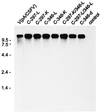Mutations abrogating the RNase activity in glycoprotein E(rns) of the pestivirus classical swine fever virus lead to virus attenuation
- PMID: 10559339
- PMCID: PMC113076
- DOI: 10.1128/JVI.73.12.10224-10235.1999
Mutations abrogating the RNase activity in glycoprotein E(rns) of the pestivirus classical swine fever virus lead to virus attenuation
Abstract
Classical swine fever (CSF) is a severe hemorrhagic disease of swine caused by the pestivirus CSF virus (CSFV). Amino acid exchanges or deletions introduced by site-directed mutagenesis into the putative active site of the RNase residing in the glycoprotein E(rns) of CSFV abolished the enzymatic activity of this protein, as demonstrated with an RNase test suitable for detection of the enzymatic activity in crude cell extracts. Incorporation of the altered sequences into an infectious CSFV clone resulted in recovery of viable viruses upon RNA transfection, except for a variant displaying a deletion of the histidine codon at position 297 of the long open reading frame. These RNase-negative virus mutants displayed growth characteristics in tissue culture that were undistinguishable from wild-type virus and were stable for at least seven passages. In contrast to animals inoculated with an RNase-positive control virus, infection of piglets with an RNase-negative mutant containing a deletion of the histidine codon 346 of the open reading frame did not lead to CSF. Neither fever nor extended viremia could be detected. Animals infected with this mutant did not show decrease of peripheral B cells, a characteristic feature of CSF in swine. Animal experiments with four other mutants with either exchanges of codons 297 or 346 or double exchanges of both codons 297 and 346 showed that all these RNase-negative mutants were attenuated. All viruses with mutations affecting codon 346 were completely apathogenic, whereas those containing only changes of codon 297 consistently induced clinical symptoms for several days, followed by sudden recovery. Analyses of reisolated viruses gave no indication for the presence of revertants in the infected animals.
Figures












Similar articles
-
Comparison of the effects of RNase-negative and wild-type classical swine fever virus on peripheral blood cells of infected pigs.J Gen Virol. 2004 Jul;85(Pt 7):1899-1908. doi: 10.1099/vir.0.79988-0. J Gen Virol. 2004. PMID: 15218175
-
Inactivation of the RNase activity of glycoprotein E(rns) of classical swine fever virus results in a cytopathogenic virus.J Virol. 1998 Jan;72(1):151-7. doi: 10.1128/JVI.72.1.151-157.1998. J Virol. 1998. PMID: 9420210 Free PMC article.
-
Removal of the Erns RNase Activity and of the 3' Untranslated Region Polyuridine Insertion in a Low-Virulence Classical Swine Fever Virus Triggers a Cytokine Storm and Lethal Disease.J Virol. 2022 Jul 27;96(14):e0043822. doi: 10.1128/jvi.00438-22. Epub 2022 Jun 27. J Virol. 2022. PMID: 35758667 Free PMC article.
-
Approaches to define the viral genetic basis of classical swine fever virus virulence.Virology. 2013 Apr 10;438(2):51-5. doi: 10.1016/j.virol.2013.01.013. Epub 2013 Feb 13. Virology. 2013. PMID: 23415391 Review.
-
Laboratory diagnosis, epizootiology, and efficacy of marker vaccines in classical swine fever: a review.Vet Q. 2000 Oct;22(4):182-8. doi: 10.1080/01652176.2000.9695054. Vet Q. 2000. PMID: 11087126 Review.
Cited by
-
Pathology and molecular diagnosis of classical swine fever in Mizoram.Vet World. 2015 Jan;8(1):76-81. doi: 10.14202/vetworld.2015.76-81. Epub 2015 Jan 24. Vet World. 2015. PMID: 27047001 Free PMC article.
-
Autonomously Replicating RNAs of Bungowannah Pestivirus: ERNS Is Not Essential for the Generation of Infectious Particles.J Virol. 2020 Jul 1;94(14):e00436-20. doi: 10.1128/JVI.00436-20. Print 2020 Jul 1. J Virol. 2020. PMID: 32404522 Free PMC article.
-
Substitution of specific cysteine residues in the E1 glycoprotein of classical swine fever virus strain Brescia affects formation of E1-E2 heterodimers and alters virulence in swine.J Virol. 2011 Jul;85(14):7264-72. doi: 10.1128/JVI.00186-11. Epub 2011 May 11. J Virol. 2011. PMID: 21561909 Free PMC article.
-
Immune Responses Against Classical Swine Fever Virus: Between Ignorance and Lunacy.Front Vet Sci. 2015 May 7;2:10. doi: 10.3389/fvets.2015.00010. eCollection 2015. Front Vet Sci. 2015. PMID: 26664939 Free PMC article. Review.
-
Alternative translation contributes to the generation of a cytoplasmic subpopulation of the Junín virus nucleoprotein that inhibits caspase activation and innate immunity.J Virol. 2024 Feb 20;98(2):e0197523. doi: 10.1128/jvi.01975-23. Epub 2024 Jan 31. J Virol. 2024. PMID: 38294249 Free PMC article.
References
-
- Baker J C. Bovine viral diarrhea virus: a review. J Am Vet Med Assoc. 1987;190:1449–1458. - PubMed
-
- Benner S A, Allemann R K. The return of pancreatic ribonucleases. Trends Biochem Sci. 1989;14:396–397. - PubMed
-
- D’Alessio G. New and cryptic biological messages from RNases. Trends Cell Biol. 1993;3:106–109. - PubMed
-
- D’Alessio G, Di Donato A, Parente A, Picoli R. Seminal RNase: a unique member of the ribonuclease superfamily. Trends Biochem Sci. 1991;16:104–106. - PubMed
MeSH terms
Substances
LinkOut - more resources
Full Text Sources
Other Literature Sources

